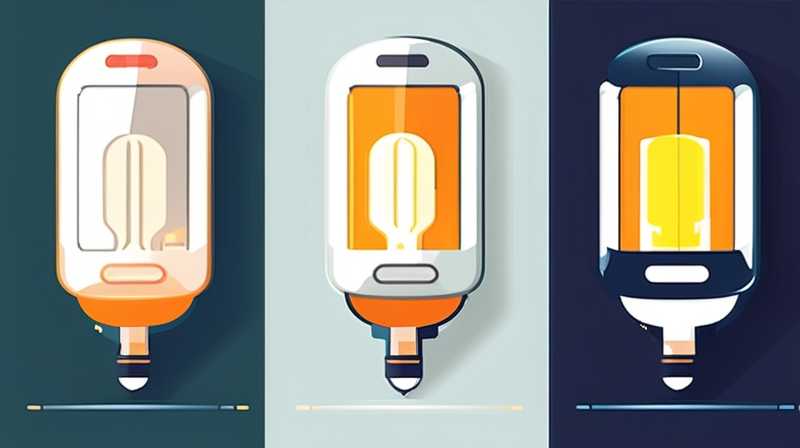
To charge a portable solar charging lamp, follow these essential steps: 1. Locate your solar panel, 2. Ensure direct sunlight, 3. Connect the lamp appropriately, 4. Monitor the charging time. Each of these elements plays a vital role in effectively harnessing solar energy to power the lamp.
- LOCATING THE SOLAR PANEL
Finding the solar panel within your portable lamp setup is crucial for optimal functionality. Solar panels are designed to capture sunlight, converting it into electrical energy that can then charge the internal battery of the lamp. Typically, these panels are situated on the top or side of the lamp. Ensure that when you position the lamp for charging, the solar panel remains unobstructed by any foreign objects.
Moreover, remember that the quality and efficiency of solar panels can vary significantly based on their construction materials and design. Higher-quality panels tend to capture sunlight more effectively, allowing for quicker charging times. It’s also beneficial to familiarize oneself with any manufacturer’s guidelines regarding the solar panel’s orientation. Depending on the model, some panels may have specific recommendations to maximize solar absorption.
- ENSURING DIRECT SUNLIGHT
For efficient charging, the solar lamp must be placed in an area that receives ample sunlight throughout the day. When determining the ideal location, consider nearby trees, buildings, or awnings that may cast shadows on the lamp. Positioning the lamp away from these obstructions can significantly enhance charging outcomes.
Additionally, the time of year can affect sunlight availability. During winter months, the sun’s angle decreases, leading to shorter and potentially less intense days. It is important, therefore, to ensure that the lamp is exposed to sunlight consistently, particularly during peak sunlight hours, usually from mid-morning to late afternoon. Utilizing solar technology during these times will ensure the lamp gains adequate power for optimal use.
- CONNECTING THE LAMP
Many portable solar charging lamps come with user-friendly features designed for effortless operation. Generally, they include either a direct charging option or the ability to recharge through a USB port. If your lamp has a direct plugging option, ensuring that the cables are properly connected is paramount. Always follow manufacturer instructions to ensure safe and effective connections.
In cases where USB charging is offered, the lamp can often be charged even in the absence of sunlight using an alternative power source. This dual capability is advantageous, enabling users to power their lamp even during overcast days. However, it often prolongs the necessity for solar charging if used frequently. Therefore, one must be judicious in deciding when to utilize each charging method.
- MONITORING THE CHARGING TIME
Setting realistic expectations about the charging duration will lead to a better experience with your solar lamp. Generally, fully charging a solar lamp can take anywhere from 4 to 10 hours of direct sunlight, depending on its battery capacity. Knowing the lamp’s specifications can help users plan better for notable functions, such as outdoor activities or emergencies.
Monitoring involves keeping track of both weather conditions and the charging process. Cloudy or rainy weather can potentially lengthen the charging time or reduce battery capacity. In such environments, it can be beneficial to employ supplementary charging methods to ensure the lamp is fully powered for its intended use.
FREQUENTLY ASKED QUESTIONS
- WHAT TYPES OF SOLAR LAMPS ARE AVAILABLE?
A myriad of solar lamps is available on the market, each designed with specific features and functions to cater to varying needs. Some popular types include garden lights, pathway lights, and portable lamps. Garden lights are often designed to enhance outdoor aesthetics, while pathway lights provide functional illumination for walkways at night. Portable lamps, such as those used for camping, have batteries that can be charged via solar energy or traditional methods. When selecting a solar lamp, consider factors such as brightness, usage duration, and intended purpose to ensure that the chosen model fits your requirements.
- HOW LONG DOES A SOLAR LAMP LAST ON A FULL CHARGE?
The duration a solar lamp can last once fully charged is dependent on several factors, including the lamp’s design, battery capacity, and brightness settings. Generally, average models can provide illumination for about 6 to 12 hours on a full charge. For instance, lamps with lower brightness settings typically use less energy, providing extended lighting hours. Conversely, models that emit bright light may deplete their battery faster. To maximize lamp longevity, regular maintenance and strategic recharging based on usage help ensure that the solar lamp remains a reliable resource for extended periods.
- CAN SOLAR LAMPS CHARGE IN NON-SUNNY WEATHER?
Although solar lamps primarily rely on sunlight for charging, they can indeed still gather some energy during cloudy or rainy weather. However, the efficiency will be significantly reduced. Charging during less-than-ideal weather conditions might yield lower battery power and shorter usage times. Users should be mindful that, while solar panels are somewhat effective during overcast days, prolonged periods without direct sunlight will necessitate alternative powering methods for optimal functionality. Utilizing a combination of charging methods can ensure reliable light when needed.
In the context of utilizing portable solar charging lamps, understanding the intricacies of their operation greatly enhances user experience. Recognizing the importance of adequate sunlight exposure and proper setup paves the way for efficient use. Indeed, proper maintenance and consideration of environmental factors will ultimately dictate the longevity and reliability of the solar lamp’s performance. The advent of solar technology offers eco-friendly solutions to energy needs, making it imperative for users to gain comprehensive knowledge about their solar devices. As renewable energy becomes increasingly integral to sustainable living, empowering oneself with information fosters not only personal utility but also contributes positively toward the environment. Cultivating an understanding of solar charging lamps holds great potential in optimizing their performance while embracing a greener lifestyle. Establishing a habit of routine checks on the solar panel, occasional battery replacements when necessary, and aligning usage to seasonal changes reinforces the reliability of solar-powered solutions in daily life.
Original article by NenPower, If reposted, please credit the source: https://nenpower.com/blog/how-to-charge-a-portable-solar-charging-lamp/


